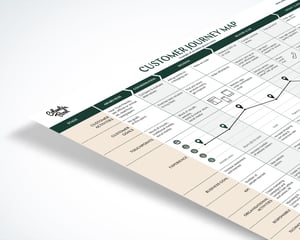The Data Handbook
How to use data to improve your customer journey and get better business outcomes in digital sales. Interviews, use cases, and deep-dives.
Get the book
Customer journey mapping is typically associated with B2C players although it is as critical in B2B settings. According to many studies (e.g. McKinsey&Company) B2B customer experience is lagging behind retail customer experience and this gap is becoming ever wider. B2B customers’ expectations are rising as business buyers’ expectations are shaped by their shopping experiences as consumers. As a result, the buyers are expecting same kind of experiences in B2B interactions.
However, when we compare B2B and B2C buyers, we can still see significant differences in their customer journeys. Even though business customers are expecting better and better experiences, their behaviour is guided by different motives and limitations than in the B2C setting. It is important to understand these unique characteristics of B2B buyers to fully understand and optimize their customer journeys.
How to start B2B customer journey mapping in 5 easy steps
We offered our customer journey map template in our earlier blog post. The same template can be used for mapping B2B customer journeys but we want to underline some points that need special attention in the B2B setting. These steps will help you to start customer journey mapping with your business’ customers.
1. Who is your customer?
There is hardly ever just one person making decisions in B2B buying process so the customer experience is based on many personal experiences. People involved in the buying process have often different roles and responsibilities and therefore varying needs and expectations. Instead of just one person, think of your customers as a portfolio of different buyer personas.
Ensuring a great and consistent experience for all buyer personas is not easy. However, it is a good start to recognize each persona at every stage of the customer journey. Clearly define these persons, their needs, expectations and relative importance - every person does not have influence on the purchase decision at every stage of the journey. Decisions makers, influencers and end-users, if they are relevant to your business, should all be mapped to the customer journey map.
2. What is your customer’s goal?
As we explained in our customer journey template blog post, it is important to understand the goals and motives of our customers. What outcome is the buyer trying to achieve? What are the needs or problems that the buyer is trying to solve? This will help you to understand your customer’s job-to-be-done and perception of value.
The goals of a business buyer are very different from a consumer’s which are more personal and emotionally triggered. B2B buyers are usually trying to achieve certain business benefits and have very specific needs. Their purchase decisions are based on efficiency, expertise, rationality and logic. Nevertheless, emotions cannot be fully forgotten because B2B buyers also want to feel trustful and confident with their decisions.
3. What are the stages of the buyer journey?
B2B purchasing process is much more complex and buying cycles are longer than in the B2C settings. B2B buyers are usually following a formal buying process and purchases are tied to budget cycles or other important deadlines. The main themes, awareness, consideration, decision, delivery & use, loyalty & advocacy, are still the same but you can add B2B-specific stages, such as contract negotiations.
B2B companies’ offerings are often complex and highly tailored, which makes the customer journey mapping even more difficult. Operations may be fragmented by account and location, and involve many people from different teams. You can start by mapping the standard journey and continue by adding specialty tracks to demanding clients. The splitting can help to minimize the complexity.
4. What are the touchpoints?
Today’s B2B buyers are using a lot of same touchpoints as consumers, especially in awareness or consideration stages. E.g. websites, blogs, Google searches and word-of-mouth are common for both customer groups. There are, though, a lot of B2B-specific touchpoints, such as sales meetings, business conferences, proposals and project kickoffs, that should also be mapped to the customer journey. Every interaction matters.
Even though B2B customers are using more and more digital channels, a lot of the traditional interactions in analogue channels remain. Customers’ preferences vary so it could be helpful to mark which channels are favored (e.g. phone calls over emails).
5. What are your own goals?
Remember to map your organization’s goals to each phase of the journey. Even though a customer journey is always based on the customer’s view, we believe that is important to write down your goals as well. These goals should be based on the customer experience strategy, not purely on sales transactions.
In the longer term, B2B buying is a lot about the relationship between buyer and seller. Try to build trust, commitment and communication through the journey. It might be a good idea to focus on customer retention and satisfaction rather than solely on conversion rates, especially if you have chosen customer intimacy as your CX strategy.
As with B2C clients, start your customer journey mapping efforts for the most important customer group or buyer persona. Once you have become familiar with the customer journeys, you can consider having one customer journey map per major B2B client so that the customer experience can be tailored and optimized. Why not start today?
 To get started, download the free customer journey map template from below. We have put together an example customer journey and offer a six step guide to get you going! You will also receive an empty template to begin mapping your customer journeys.
To get started, download the free customer journey map template from below. We have put together an example customer journey and offer a six step guide to get you going! You will also receive an empty template to begin mapping your customer journeys.
The Data Handbook
How to use data to improve your customer journey and get better business outcomes in digital sales. Interviews, use cases, and deep-dives.
Get the book




